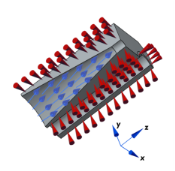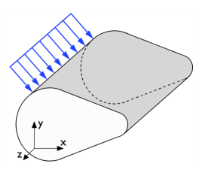The 2D physics interface for plane stress allows loads in the x and
y directions, and it assumes that these are constant throughout the material’s thickness, which can vary with
x and
y. The plane stress condition prevails in a thin flat plate in the
xy-plane loaded only in its own plane and without any
z direction restraint.
Loads in the x and
y directions are allowed. The loads are assumed to be constant throughout the thickness of the material, but the thickness can vary with
x and
y. The plane strain condition prevails in geometries, whose extent is large in the
z direction compared to in the
x and
y directions, or when the
z displacement is in some way restricted. One example is a long tunnel along the
z-axis where it is sufficient to study a unit-depth slice in the
xy-plane.
The axisymmetric variant of the Solid Mechanics interface uses cylindrical coordinates r,

(
phi), and
z. Loads are independent of

, and the axisymmetric variant of the physics interface allows loads only in the
r and
z directions.
The 2D axisymmetric geometry is viewed as the intersection between the original axially symmetric 3D solid and the half plane ϕ = 0,
r ≥ 0. Therefore, the geometry is drawn only in the half plane
r ≥ 0 and recover the original 3D solid by rotating the 2D geometry about the
z-axis.




